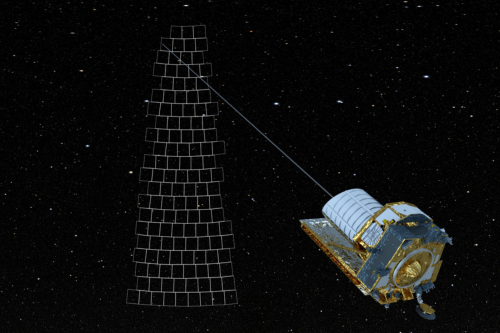
Euclid scans across the night sky using a 'step-and-stare' method, combining separate measurements to form the largest cosmological survey ever conducted in the visible and near-infrared. ESA
A pioneering satellite mission to map and help unravel the mysteries of the universe will launch this week, with University of Bristol researchers playing a pivotal role in the project.
The European Space Agency's (ESA) Euclid flagship Dark Energy Satellite Mission is due to launch from Cape Canaveral in Florida at 11am EDT (4pm. BST) on Saturday 1 July, on a SpaceX Falcon 9 rocket.
Euclid's six-year mission is to chart the dark universe, using the positions of galaxies and images of dark matter produced from the 'gravitational lensing distortions' of distant galaxies. The galaxy and dark matter maps contain information about the expansion history of the universe and the evolution of the structure within it.
Dr Sotiria Fotopoulou, Vice Chancellor's Fellow in the University of Bristol School of Physics, is involved in identification of stars and galaxies used in gravitational lensing analysis, and the study of supermassive black holes. She said: "Euclid will transform the way we do astronomy, both through precise cosmological measurements and through its vast legacy value across all areas of astrophysics. I am particularly excited to better understand the population of supermassive black holes found in the centres of galaxies."
By analysing these maps, astronomers will be able to determine the nature of both dark matter and dark energy. Dark matter, which unlike normal matter does not reflect or emit light, binds together galaxies creating the environment for stars, planets and life, while dark energy is the mysterious new phenomenon which is pushing galaxies away from each other and causing the expansion of the Universe to accelerate.
To achieve this, the Euclid Consortium team will carry out a very precise and accurate analysis of the images and distances of 1.5 billion galaxies over one-third of the sky. Euclid will also measure the spectrum of light from over 35 million galaxies to accurately measure their distance from Earth.
To carry this out the Euclid satellite hosts two state-of-the-art instruments, an optical camera (VIS) built in the UK, and a Near-Infrared (NISP) camera led by France. The VIS Instrument will take images as sharp as those from the Hubble Space Telescope (HST) to measure the gravitational lensing distortions. The NISP Instrument will take multicolour images and the spectrum of light of galaxies from which their distance can be measured. Euclid's wide field of view and large instruments will allow it to image more area of sky in one day than HST in its first 25 years.
After launch, Euclid will travel over one million miles into space away from the sun, where the combined gravity of the sun and earth will cause it to orbit the sun once a year, in step with the earth. It will scan the sky and send data back to ESA's ground stations. From there Euclid's data is distributed across nine Euclid Science Data Centres located in Europe, and one in North America. The UK's Science Data Centre is hosted in Edinburgh.
These Data Centres will then process the Euclid data, along with data from complementary ground-based astronomical surveys, day and night, ready for teams of scientists to work on, with the results released to the public. To realise Euclid's ambitious mission, more than 2,000 scientists from Europe, including many from the UK, along with the European Space Agency and industrial teams, have assembled to design and build Euclid and to analyse the data from it.
Professor Ben Maughan, also from the University of Bristol School of Physics, has been preparing to study clusters of galaxies in the Euclid data. These are enormous collections of hundreds or thousands of galaxies, along with a far greater amount of dark matter.
Professor Maughan said: "Euclid will detect around a million clusters of galaxies, including some of the first ones to form in the early universe. Crucially, for many clusters Euclid's images of the gravitational lensing distortions that they cause will be used to measure exactly how massive they are. This is the key to understanding these amazing cosmic structures."
The UK has been involved in the design and building of Euclid from its earliest days, co-leading the teams defining the science programme and observational strategy, leading the construction of the VIS Instrument, leading the gravitational lensing data analysis and production of its high-level data products, and coordinating the science analysis for Euclid, along with many other roles.






